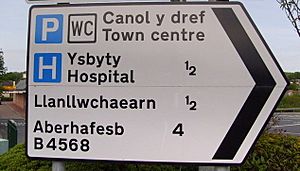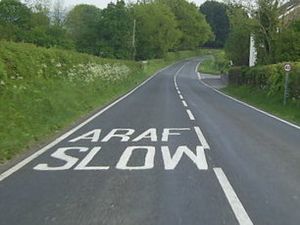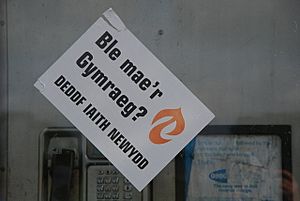Road signs in Wales facts for kids

Road signs in Wales follow the same design principles as those in other parts of the United Kingdom. All modern signs feature both Welsh- and English-language wording, with Welsh first signage present in some areas of Wales and mandated for all new signs, but some English first signage remains when it was legally allowed before 2016.
Contents
Current policy
New regulations that came into force in 2016 mandate that all signs be in Welsh first, with the existing "English-priority" signage (in those areas where the local authority previously had such a policy) being replaced whenever they otherwise would (life expiry or altered road conditions). The Welsh Government states in its Welsh Language Standards, Article 119, page 17, that; 'Where a sign contains the Welsh language as well as the English language, the Welsh language text must be positioned so as to be read first.' and; 'Replacement signage on Welsh Government trunk roads will be taken forward as part of general rolling programme of renewals with priority given to main routes.' The previous Welsh Language Scheme stated that English-only signs would be made bilingual when they were replaced, and that the order in which the languages appear would follow the practice adopted by the local authority where the sign is located.
Bilingual signing
Bilingual signs in Wales were permitted by special authorisation after 1965. In 1972 the Bowen Committee recommended that they should be provided systematically throughout Wales. Throughout Wales, instructions for drivers appear on the road itself. One of the most common painted instructions is araf – slow.
Errors
The requirement for bilingual signs has sometimes led to errors, such as the two languages presenting differing information. In 2006, a bilingual pedestrian sign in Cardiff told pedestrians to "look right" in English, but "edrychwch i'r chwith" ("look left") in Welsh. In 2008, a sign erected near the entrance to a supermarket in Swansea was mistakenly printed with an automatic e-mail response which read "Nid wyf yn y swyddfa ar hyn o bryd. Anfonwch unrhyw waith i'w gyfieithu" which translates as "I am not in the office at the moment. Send any work to be translated."
See also
- Welsh Government
- List of Welsh principal areas by percentage Welsh language



